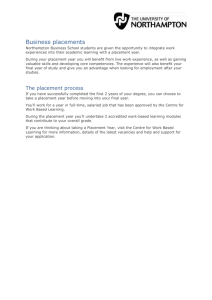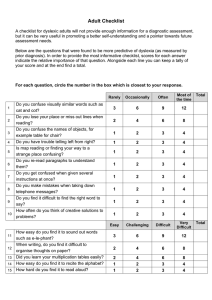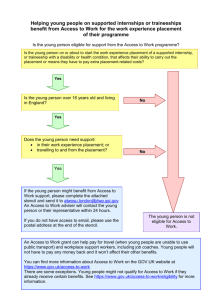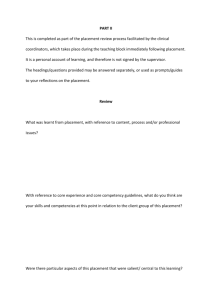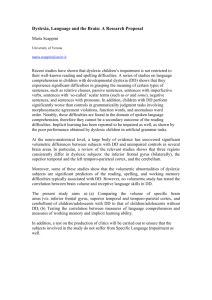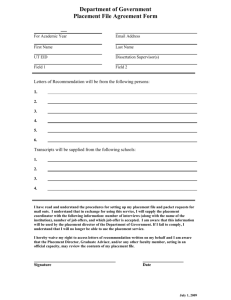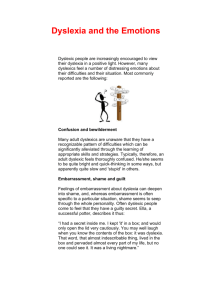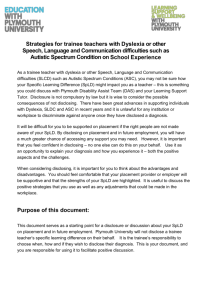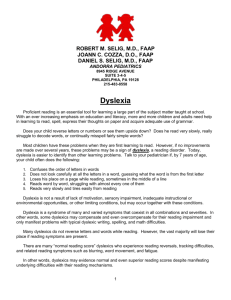Difficulties and suggested strategies for helping dyslexic students on
advertisement
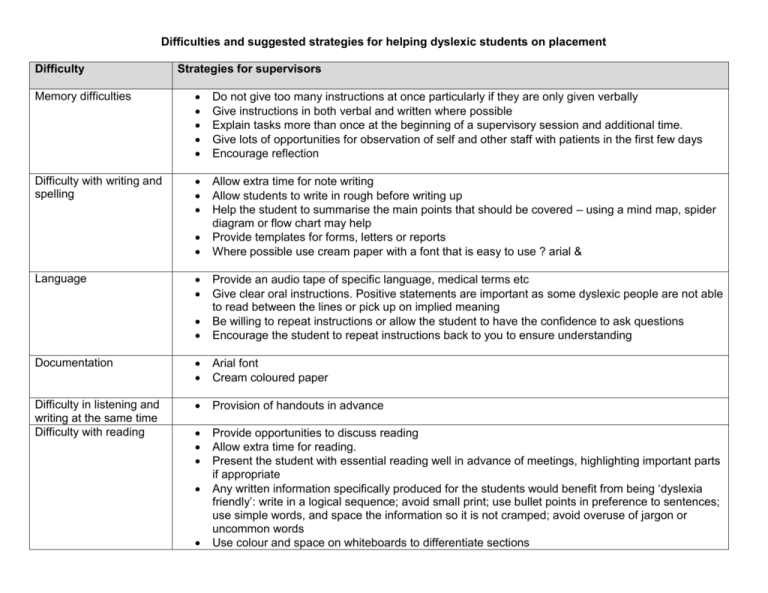
Difficulties and suggested strategies for helping dyslexic students on placement Difficulty Strategies for supervisors Memory difficulties Do not give too many instructions at once particularly if they are only given verbally Give instructions in both verbal and written where possible Explain tasks more than once at the beginning of a supervisory session and additional time. Give lots of opportunities for observation of self and other staff with patients in the first few days Encourage reflection Difficulty with writing and spelling Allow extra time for note writing Allow students to write in rough before writing up Help the student to summarise the main points that should be covered – using a mind map, spider diagram or flow chart may help Provide templates for forms, letters or reports Where possible use cream paper with a font that is easy to use ? arial & Language Provide an audio tape of specific language, medical terms etc Give clear oral instructions. Positive statements are important as some dyslexic people are not able to read between the lines or pick up on implied meaning Be willing to repeat instructions or allow the student to have the confidence to ask questions Encourage the student to repeat instructions back to you to ensure understanding Documentation Arial font Cream coloured paper Difficulty in listening and writing at the same time Difficulty with reading Provision of handouts in advance Provide opportunities to discuss reading Allow extra time for reading. Present the student with essential reading well in advance of meetings, highlighting important parts if appropriate Any written information specifically produced for the students would benefit from being ‘dyslexia friendly’: write in a logical sequence; avoid small print; use bullet points in preference to sentences; use simple words, and space the information so it is not cramped; avoid overuse of jargon or uncommon words Use colour and space on whiteboards to differentiate sections Carrying out procedures If a task involves following a sequence, this could be set out clearly on a wall chart or instruction sheet. Demonstrate skills more than once at the beginning of the placement Supervise practice until the student is secure Diagrams can help Encourage use of calculator or other preferred learning aid Supervise drug administration Demonstrate understanding of difficulties experienced Indicate what is in place to help Has difficulty dealing with more than one thing at a time Time management Avoid overloading with information Encourage to make to do lists taking in to account priorities Suggest timescales Check they have a watch Other Provide a map of the hospital/building/unit Provide a placement pack setting out useful information Difficulty with numeracy Lack of confidence / low self-esteem Difficulty Strategies for students Memory difficulties Use a diary to note daily tasks agreed with supervisor Use colour pens, highlighters, flow charts to organise and prioritise work Use a personal note pad or electronic diary Create a flow chart on a small card as a memory aid Repeat tasks back to check full understanding Request small chunks of information at a time Ask for practical skills to be demonstrated Devise some prompt sheets to help with sequencing tasks Have appropriate telephone pads available for taking messages with as much information filled out beforehand Difficulty with writing and spelling Be familiar with the layout of forms. Take one home to familiarise yourself with the layout Use a recording device to record ideas if possible whilst maintaining cpatient confidentiality Keep a record of common words and those specific to the placement specialty Devise effective checking procedures and proofreading skills. Use laptop or PC for writing case notes (if available) Language Documentation of forms Build a list of words that are frequently used in the area Ask for clarification if you are not sure of the terminology Use specialised reference books such as ‘Mosby’s Medical Drug Reference’ which gives the pronunciation of words Spell check pens Bullet points to minimise punctuation Double check work Write notes early as you go along List of terminology commonly used Difficulty in listening and writing at the same time Dictaphone when appropriate Difficulty with reading Use coloured overlays Ask for or initiate opportunities to discuss reading Ask for extra time for reading. Ask for essential reading in advance of placement, meetings, etc highlighting important parts if Difficulty with reading (cont) appropriate Work in a quiet area Read small amounts at a time Take regular breaks Carrying out procedures Ask for extra time to practice skills you are unfamiliar with Write the sequence down in the form of a spider diagram or flow chart Difficulty with left /right confusion Mark hands left and right Use maps of hospital/building/unit Right is the hand you write with (IF right handed) Difficulty with numeracy Use calculator when appropriate Ask for drugs t be checked Lack of confidence / low self-esteem If this is related to dyslexia discuss with CE and see if there are stratgegies that are in place to support you. Has difficulty dealing with more than one thing at a time Make ‘to do’list in priority order Time management / organisational skills Have a watch Observe and question others for ideas Plan and prioritise workload using coloured highlighters, tick boxes, flow charts, lists Break down complex tasks into manageable chunks and tick when completed Other

